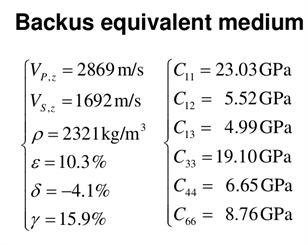Creative and daring ways
Frequency-dependent analysis of the relationship heterogeneities/anisotropy for seismic waves
These results were presented in EGS-2009 congress.
The observation scale is a main issue when studying solid matter and in particular geomaterials as they often exhibit multi-scale structures. The use of effective medium theory, when trying to account for experimental observations, is generally motivated by the need for a simple framework and sometimes by the limited quantity of data available. In geophysical prospecting, two fundamental features should be distinguished: (1) the effective medium, which is based on statistical average of a given physical parameter or observation (related to the notion of averaging volume), for instance the mean flow through a porous rock due to a fluid pressure gradient, and (2) the equivalent medium, which is related to intrinsic limitations of the physical phenomena used to investigate the material, for instance the spectral resolution of the band limited seismic waves. In this latter case, scaling problems are expected when using different wavelengths, and difficulties typically arise in oil exploration when trying to match material properties estimated from well seismic to those derived from sonic logs.
As a consequence, investigating the relationship between heterogeneity and anisotropy at different scales for seismic waves in geomaterials leads naturally to a frequency-dependent analysis.
The observation scale is a main issue when studying solid matter and in particular geomaterials as they often exhibit multi-scale structures. The use of effective medium theory, when trying to account for experimental observations, is generally motivated by the need for a simple framework and sometimes by the limited quantity of data available. In geophysical prospecting, two fundamental features should be distinguished: (1) the effective medium, which is based on statistical average of a given physical parameter or observation (related to the notion of averaging volume), for instance the mean flow through a porous rock due to a fluid pressure gradient, and (2) the equivalent medium, which is related to intrinsic limitations of the physical phenomena used to investigate the material, for instance the spectral resolution of the band limited seismic waves. In this latter case, scaling problems are expected when using different wavelengths, and difficulties typically arise in oil exploration when trying to match material properties estimated from well seismic to those derived from sonic logs.
As a consequence, investigating the relationship between heterogeneity and anisotropy at different scales for seismic waves in geomaterials leads naturally to a frequency-dependent analysis.
Propagation in heterogeneous rock samples: fracture case
Propagation in heterogeneous rock samples: fracture, bedding and cracks
Fracture and bedding (with a source of frequency 2MHz and 8MHz)
Fracture, bedding and cracks (with a source of frequency 2MHz and 8MHz)
Modeling the anisotropy: Propagation in a homogeneous equivalent anisotropic medium (VTI)
We realized 100 seismic modeling using 100 different models, the medium was a thin layered elastic medium with the following bimodal distribution of the P-wave velocity in layers.
We realized 100 seismic modeling using 100 different models, the medium was a thin layered elastic medium with the following bimodal distribution of the P-wave velocity in layers.
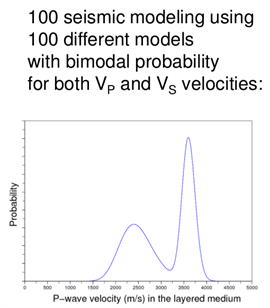
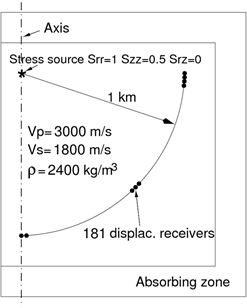
Experiment 12
Experiment 33
The seismograms for these two experiments are shown below. In red is figured the picks of the experiment, in green the mean picks for the 100 experiments and in blue the picks for the equivalent medium. The mean travel-time errors were smaller than 1ms (difference between blue and green).
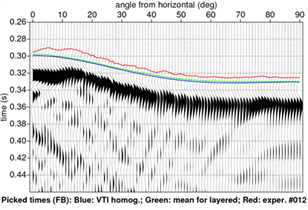
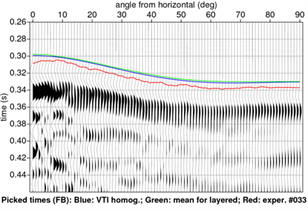
The Backus equivalent medium is used to model the anisotropy.
